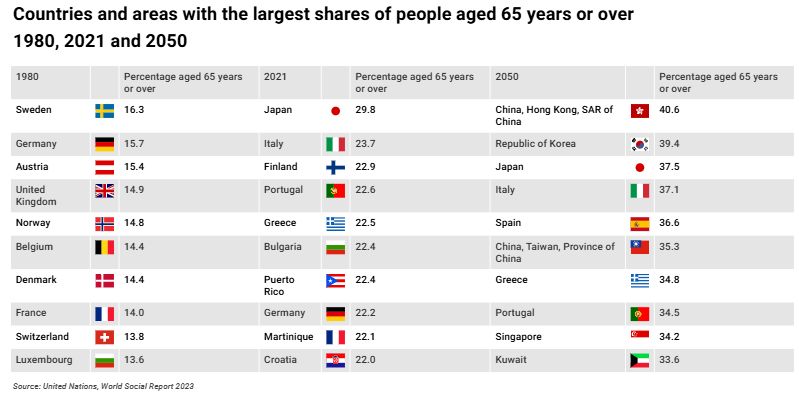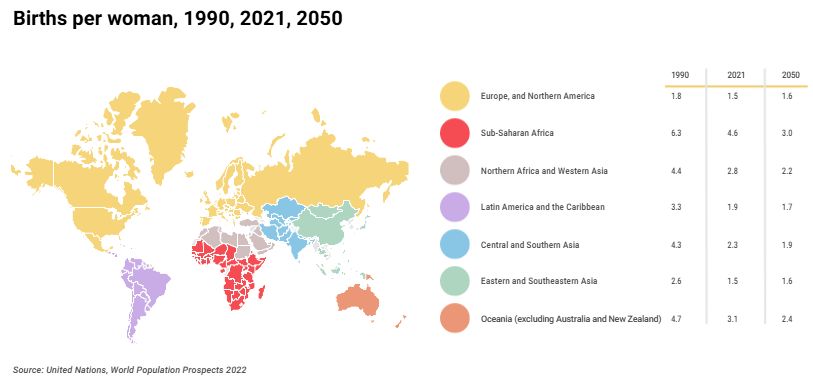Both in regions that have experienced a population surge
over recent decades and in economies in which the population is
gradually shrinking, transition is the hallmark of our times and
the shifts entailed carry substantial implications for the
employment market. To remain relevant and competitive, businesses
will need to proactively consider population trends when planning
their workforce strategies. So today, as the world celebrates UN
World Population Day, we explore the key demographic trends
affecting labour markets across regions and countries.
One of the most significant demographic trends globally is the
ageing population. The number of people aged 65 and over is set to
more than double, increasing from 761 million in 2021 to 1.6
billion by 2050. The number of those aged 80 and above is growing
even more rapidly, rising from 155 million in 2021 to 459 million
by 2050.
Population ageing is an irreversible global trend, driven by longer life expectancy and smaller family sizes. In 2021, one in ten people worldwide were aged 65 or older. By 2050, this age group is projected to represent one in six. Regions such as Northern Africa, Western Asia, and Sub-Saharan Africa are expected to see the fastest growth in their older populations over the next three decades. Currently, Europe and Northern America have the highest proportion of older individuals.
For comparison, in 1980, in Europe's ten oldest populations, about 15% of their residents were aged 65 or older. By 2021, this proportion had risen above 20% in all ten countries, and it is expected to reach 30% by 2050. Although Japan had the world's oldest population in 2021, it is anticipated that China, Hong Kong SAR, and South Korea will surpass it before 2050. Consequently, the world's oldest populations will shift geographically from Europe towards Eastern and South-Eastern Asia, with the latter expected to include five of the ten oldest populations by 2050 (UN, World Social Report 2023).

Other factors reshaping the future population are birth rates and life expectancy. Regarding birth rates, the world has seen significant changes since the mid-twentieth century. In 2021, the global average fertility rate was 2.3 births per woman, a sharp decline from about five births per woman in the mid-20th century. At present, two-thirds of the world's population live in countries where fertility rates are below the replacement level of 2.1 births per woman. This decline is attributed to various factors, including better access to education and healthcare, increased use of contraception and evolving social norms concerning family size and gender roles. Projections suggest that this decline will continue, with fertility rates expected to drop further by 2050 (UN, World Population Prospects 2022).

Life expectancy has undergone dramatic changes in recent decades as well. According to the United Nations Population Division, global life expectancy at birth for both sexes has increased from 46.5 years in 1950 to 71.7 years in 2022 and is projected to reach 77.3 years by 2050. Between 1950 and 2000, life expectancy in Asia rose by more than 25 years, narrowing the gap with North America and Europe from over 20 years to less than 10 years. By 2050, Asia is expected to nearly match the Western world's life expectancy, approaching 80 years. Africa, however, is the only region expected to lag behind the rest of the world in life expectancy by 2050. This remarkable increase in life expectancy can be attributed to several factors, including advancements in medical technology, improved access to healthcare, better nutrition and enhanced public health initiatives.
Takeaway for employers
These demographic shifts place significant strain on the labour market. In countries where the population is ageing and birth rates are declining, businesses may encounter a shrinking pool of young, entry-level workers. This could lead to labour shortages, increased wage pressures and a heightened need for investment in automation and technology to sustain productivity. However, businesses that proactively adapt to these changes through flexible workforce policies, strategic use of technology and inclusive practices will be better positioned to thrive in the future.
The content of this article is intended to provide a general guide to the subject matter. Specialist advice should be sought about your specific circumstances.

